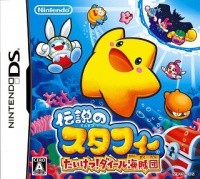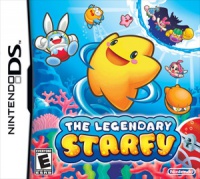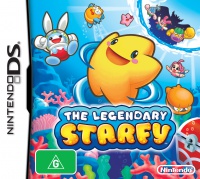The Legendary Starfy/Regional differences/distribution
From Starfy Wiki
This is a sub-article of User:Torchickens/The Legendary Starfy/Regional Differences
This article covers regional differences relating to the distribution of Densetsu no Starfy Daīru Kaizokudan, known in North America and Australasia as The Legendary Starfy.
Box-Art
There are a number of differences between the Japanese, North American and Australasian box-arts.
-
Densetsu no Starfy Dairu Kaizokudan Japanese Boxart -
The Legendary Starfy
North American Boxart -
The Legendary Starfy
Australasian Boxart
Front
- Similarly to other Nintendo DS games, such as Pokémon Diamond the Japanese box of Densetsu no Starfy Daīru Kaizokudan is decorated with iridescent glitter. These include bubble and rhombus-like shapes. The iridescent effect is not present on the North American and Australasian boxes.
- Like other Japanese Nintendo DS games, the spine of the Japanese box of Densetsu no Starfy Daīru Kaizokudan features the name of the game written in plain white text on a black background, the Nintendo logo, and the CERO 'A' rating. English and Australasian versions have spines featuring the actual 'The Legendary Starfy' logo next to artwork of Starfy. These are placed on a background resembling the sea instead of the Japanese box's black background.
- The original artwork of Starfy has Starfy facing the front with a large grin. In the North American and Australasian box-arts, the grin is thinner and is shaped more like an elongated 'D'. In the North American and Australasian box-arts Starfy faces more to the side, performing a Spin Attack (English games: Star Spin).
- It appears that the positioning of some artwork on the boxes has shifted.
- On the Japanese box-art, more of the red treasure chest (bottom-right corner) is visible. On North American and Australasian versions about half of it is cut off the right side of the box-art.
- On the Japanese box-art, less of the coral and sea-weed is visible.
- The Japanese box-art features more bubbles behind Starfy compared to the North American and Australasian versions.
Minor Changes
- The Densetsu no Starfy logo was made wider in English and Australasian versions so that it would fit the text 'The Legendary Starfy' more suitably. The Japanese version features furigana and the text 'たいけつ!ダイール海賊団' (Dire Pirate Squad) below the logo on a background made to look like a wooden board.
- In all three versions, bubbles surround the red treasure chest. On the North American and Australasian versions the bubbles were re-positioned so that they appear to come out of the keyhole.
- There are small differences near the scene featuring the Dire Pirate Squad (English: The Terrible Trio) between the Japanese, North American and Australasian box-arts.
- More white dots are visible on Daīru's (English: Mashtooth) silhouette on the Japanese version.
- The cloud patterns are different.
- On the Japanese box-art, Densetsu no Starfy is marked with a registered trademark (®) symbol. On the North American and Australsian box-arts, The Legendary Starfy is marked with the regular trademark symbol (™).
- On the Japanese box-art, the Nintendo logo is printed on the top-left of the artwork. On the North American and Australsian box-arts, the Nintendo logo is printed on the bottom-right of the artwork instead. On Australsian boxes, the logo is the same size as it is on Japanese boxes. The logo is smaller on North American boxes.
- The bottom-right corner of the Japanese box-art features the product ID (NTR-YSSJ-JPN). English and Australasian games only have this written on the game card and the back of the box.
- The 'Nintendo DS' text is larger on North American and Australasian box-arts. The black section separating it from the box-art is also blurrier.
- On the Japanese and Australasian boxes, 'Nintendo DS' is marked with a registered trademark (®) symbol. On the Australasian box, The Legendary Starfy is marked with the regular trademark symbol (™).
Back
Ratings
- Densetsu no Stafy Dairu Kaizokudan was originally rated in Japan by the CERO 'A', as in 'All ages'. The North American and Australasian versions use different rating systems. The North American version is rated by the ESRB 'E' for 'Everyone', and the Australasian version is rated by the Australian Classification Board 'G' for General audience. All ratings are visible on the bottom-left of the box. The ratings on the Japanese and Australian boxes are also visible on the spine. The rating on the North American box is visible on the bottom-left of the box only.


